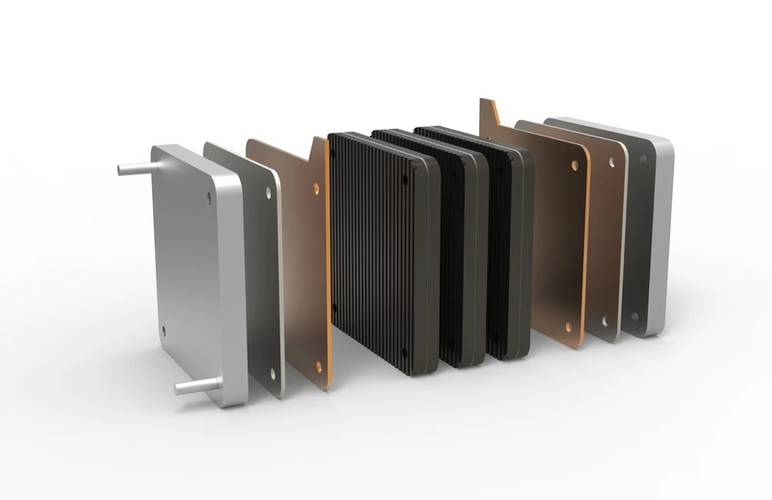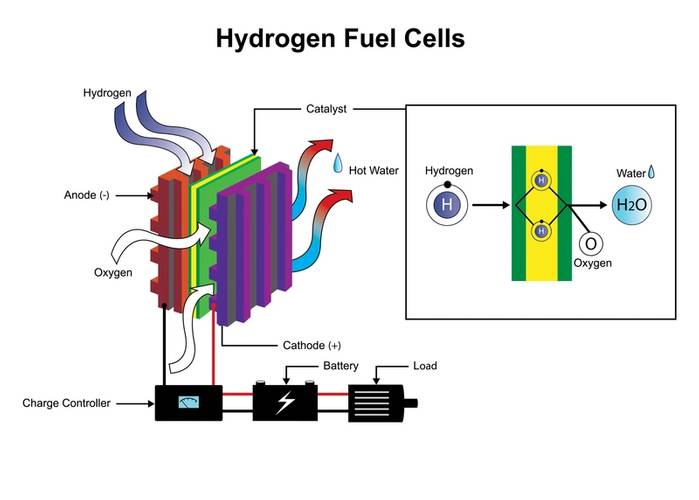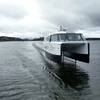Fuel Cells: industry examines options in race to zero emissions
A maritime consortium, including ABS and Sandia National Laboratories, recently proved the viability of a hydrogen fuel cell ferry designed for operations in the environmentally sensitive San Francisco Bay area.
The IMO’s mandate to cap the sulfur content in marine fuel at the start of next year may be the biggest regulatory change in shipping since the requirement for double hulls, but the challenge will fade in comparison to its future goals to reduce green-house gases (GHG).
A year ago (April 2018), the IMO agreed to a preliminary strategy that targeted a minimum 40% reduction in CO2 emissions on a cargo-tonne mile basis by 2030, and a 50% reduction in GHG emissions from shipping by 2050. To support and inform that goal, the mandatory collection of emissions data from ships started in January. The IMO’s final strategy will be unveiled in 2023. In the interim, it is committed to release its fourth GHG study, and to analyze and report the findings from three years of having collected data on the industry’s emissions.
The mandatory global targets to reduce the emissions from shipping are the most ambitious yet: they will require measures that combine improvements in ship design; the creation of new fuels and alternative forms of propulsion; operational changes; and the application of digital technology. Because those goals are unlikely to be met without the development of new technology, industry and governments will need to expand the resources they make available for research and development.
A technology with potential
One area of promise for energy generation onboard ships is fuel cells. Fuel cells are presently used in a variety of land applications, such as to provide power in remote areas, as well as for industrial, residential and commercial buildings. Energy from hydrogen fuel cells, in particular, is already used in land-based transport vehicles, such as municipal buses, trains and heavy-duty trucks, as well as for industrial equipment such as forklifts.
While submarines have been built recently with hybrid propulsion units using hydrogen fuels cells, its use in the commercial shipping sector largely has been limited to auxiliary purposes: fuel cells can provide shipboard heat and power – including ‘hotel’ power, such as that required on cruise ships – and ‘cold ironing’, providing an alternative shoreside power source that allows ships to shut down their engines while at dock, lessening their emissions output.
Additionally, there has been a lot of research and prototyping in the maritime sector to investigate applications on small passenger ferries and other short-sea vessels. ABS, in partnership with Sandia National Laboratories, recently confirmed the feasibility of high-speed, hydrogen-fueled ferries for use in the San Francisco Bay area. Separately, Norway late last year provided the funding for construction of a hydrogen-powered high-speed ferry and a short-sea freighter.
Potential, and Challenges
Hydrogen fuel cells technology has the potential to offer reliable, long-range power on an industrial scale, with relatively quick refueling when compared to the emerging battery-powered options. Hydrogen itself has higher energy density than batteries, potentially making fuel-cell systems more practical for operators looking to replace or supplement traditional bunker-fuelled propulsion units.
However, sourcing of hydrogen can be energy intensive. Without the incorporation of renewably generated hydrogen, the net impact on GHG gas for hydrogen produced by methane or similar processes is negligible. Also, adopting hydrogen as a deepsea marine fuel is not without challenges, even before safety factors are considered.
It is important to compare the energy density of different energy sources – including fuel cells – to better understand how they need to mature before they will be suitable for global shipping, where the carriage of cargo is the main focus. In general, fuel cell systems require less maintenance (potentially offering lower maintenance costs) and long service lives. They also generate less noise than present heavy oil power plants, contributing to a more comfortable work environment for the crew and less disruption for the surrounding marine life.
The suitability of fuel cell systems for hybrid propulsion solutions – coupled with diesel – has an extensive track record. But perhaps most importantly for proactive owners looking for a path to IMO emissions compliance in 2030 and 2050, hydrogen fuel cell systems would generate zero GHGs; their only by-product from energy generation is water. Another key challenge will be for the marine industry to develop a hydrogen-distribution system that is capable of producing and distributing the significant quantities required for a global network of large ships.
The refineries are adjusting their production processes to accommodate increases in demand as alternate fuels gain popularity, but the supply networks will need to mature before the marine industry will feel confident enough to widely adopt power systems that utilize fuel cells. As a power generation technology, fuel cells are comparatively mature. Shipowners may want to look at the technology as something more than a ‘future fuel’ and instead recognize its present benefits to the marine industry as they act to reduce the carbon footprints of their fleets and steer towards a more sustainable future.
How fuel cell systems work
A fuel cell is a device that converts the chemical energy from a fuel into electricity via an electrochemical reaction of the fuel with oxygen, or other oxidizing agents. They differ from batteries in that fuel cells require a continuous source of fuel and oxygen (usually from the air) to sustain the chemical reaction, whereas the availability of energy from a battery is fixed by the amount of energy it has stored. Fuel cells can produce electricity continuously as long as fuel and oxygen are supplied to them.
There are many types of designs for fuel cells. Most consist of an anode, cathode and an electrolyte that allows positively charged hydrogen ions (known as protons) to move from the anode to the cathode side of the fuel cell.
Safety and emerging regulation
There are currently no IMO regulations to provide prescriptive requirements for fuel cell installations; they are in the process of being developed. These developments are being reviewed as an extension of low flash point fuel requirements. Safety issues pertaining to gaseous fuels such as hydrogen, methane and other ‘lighter-than-air’ fuels, or propane (which is heavier than air), need special arrangements for ventilation to prevent the formation of the hazardous areas that are prone to explosion.
For many fuel cells, the non-hydrogen supply is externally reformed to hydrogen and other byproducts prior to introduction into the fuel cell. So the hydrogen portion of the fuel system – from the reformer to the fuel cell - needs careful design consideration and features.
Safety and operational reviews of fuel cell installations for marine and offshore assets primarily rely on risk-based studies in combination with IMO vessel regulations, IACS requirements, the applicable industrial standards and Rules or Guides based on the particular design and configuration of the fuel cell system.
The International Code of Safety for Ships Using Gases or Other Low-Flashpoint Fuels, known as the IGF Code, is currently being revised to address the requirements for fuel cell systems; it is anticipated by industry that this will assist with the present safety challenges.
To support and promote a safer and more sustainable practice as the industry increasingly adopts fuel cell systems, ABS will soon publish a Fuel Cell Guide on marine applications for the technology, including propulsion and other auxiliary uses. It will offer a structured approach to the application of fuel cell systems in a format that is flexible enough to include other gaseous fuels and any future technological upgrades.
Shipowners are facing some challenging environmental decisions as more stringent regulations shift the course of their industry towards a more sustainable future: a 0.5% sulphur cap on fuel by the end of this year; a minimum 40% reduction in CO2 emissions from ships by 2030; a 50% reduction in GHG output by 2050; and potentially even more ambitious goals set by regional and national governments.
It may be time for them to start to consider what if any role fuel cells could play in providing a solution.
Mr. Carlucci is currently the ABS Manager for Machinery, Electrical and Controls Technology. Since joining ABS in 2008 Carlucci has held several senior roles in asset integrity management, life cycle risk and reliability, design and plan review, and product and service development. With extensive experience in the marine and offshore industries, Carlucci’s expertise includes: hybrid power applications, ship systems operations and maintenance, systems designs, risk and reliability analysis (FMEA, RCM), and condition/performance monitoring. He served in the U.S. Navy as a Nuclear trained Surface Warfare Officer. Mr. Carlucci received his Bachelors of Science in Mechanical Engineering from Duke University and a Master’s in Business Administration from University of Houston.
This article first appeared in the March 2019 print edition of MarineNews magazine.




















